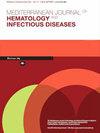ASSOCIATION BETWEEN LEUKEMIC EVOLUTION AND UNCOMMON CHROMOSOMAL ALTERATIONS IN PEDIATRIC MYELODYSPLASTIC SYNDROME
IF 2
4区 医学
Q3 HEMATOLOGY
Mediterranean Journal of Hematology and Infectious Diseases
Pub Date : 2024-01-01
DOI:10.4084/mjhid.2024.003
引用次数: 0
Abstract
Background and objective: Pediatric myelodysplastic syndrome (pMDS) is a group of rare clonal neoplasms with a difficult diagnosis and risk of progression to acute myeloid leukemia (AML). The early stratification in risk groups is essential to choosing the treatment and indication for allogeneic hematopoietic stem cell transplantation (HSCT). According to the Revised International Prognostic Scoring System, cytogenetic analysis has demonstrated an essential role in diagnosis and prognosis. In pMDS, abnormal karyotypes are present in 30-50% of the cases. Monosomy 7 is the most common chromosomal alteration associated with poor prognosis. However, the rarity of specific cytogenetic alterations makes its prognosis uncertain. Thus, this study aimed to describe uncommon cytogenetic alterations in a cohort of 200 pMDS patients and their association with evolution to AML. Methods: The cytogenetic analysis was performed in 200 pMDS patients by G-banding and fluorescence in situ hybridization between 2000 to 2022. Results: Rare chromosome alterations were observed in 7.5% (15/200) of the cases. These chromosome alterations were divided into four cytogenetic groups: hyperdiploidy, biclonal chromosomal alterations, translocations, and uncommon deletions, which represented 33.3%, 33.3%, 20%, and 13.3%, respectively. Most of these patients (10/15) were classified with advanced MDS (MDS-EB and MDS/AML) and the initial subtype was present in five patients (RCC). The leukemic evolution was observed in 66.66% (10/15) of the patients. Most patients had poor clinical outcomes and they were indicated for HSCT. Conclusion: The study of uncommon cytogenetic alterations in pMDS is important to improve the prognosis and guide early indication of HSCT. Keywords: Pediatric MDS; Leukemic evolution; rare chromosomal altwerations; HSCT, Children小儿骨髓增生异常综合征中白血病演变与不常见染色体改变之间的关系
背景和目的:小儿骨髓增生异常综合征(pMDS)是一组罕见的克隆性肿瘤,诊断困难,且有发展为急性髓性白血病(AML)的风险。早期进行风险分层对于选择治疗方法和异基因造血干细胞移植(HSCT)的适应症至关重要。根据 "修订版国际预后评分系统",细胞遗传学分析在诊断和预后中起着至关重要的作用。在pMDS中,30%-50%的病例存在核型异常。 单体 7 是与不良预后相关的最常见染色体改变。然而,特定细胞遗传学改变的罕见性使其预后不确定。因此,本研究旨在描述 200 例 pMDS 患者中不常见的细胞遗传学改变及其与急性髓细胞性白血病演变的关系。研究方法在2000年至2022年期间,通过G-带和荧光原位杂交对200例pMDS患者进行了细胞遗传学分析。结果在7.5%(15/200)的病例中观察到罕见的染色体改变。这些染色体改变分为四组细胞遗传学组别:超二倍体、双克隆染色体改变、易位和不常见缺失,分别占 33.3%、33.3%、20% 和 13.3%。其中大多数患者(10/15)被归类为晚期 MDS(MDS-EB 和 MDS/AML),5 名患者(RCC)出现初始亚型。66.66%的患者(10/15 例)出现白血病演变。大多数患者的临床疗效不佳,需要进行造血干细胞移植。 结论研究 pMDS 中不常见的细胞遗传学改变对于改善预后和指导造血干细胞移植的早期指征非常重要。关键词小儿 MDS;白血病演变;罕见染色体改变;造血干细胞移植,儿童
本文章由计算机程序翻译,如有差异,请以英文原文为准。
求助全文
约1分钟内获得全文
求助全文
来源期刊

Mediterranean Journal of Hematology and Infectious Diseases
Medicine-Hematology
CiteScore
4.20
自引率
6.20%
发文量
113
审稿时长
12 weeks
期刊介绍:
Reciprocal interdependence between infectious and hematologic diseases (malignant and non-malignant) is well known. This relationship is particularly evident in Mediterranean countries. Parasitosis as Malaria, Leishmaniosis, B Hookworms, Teniasis, very common in the southeast Mediterranean area, infect about a billion people and manifest prevalently with anemia so that they are usually diagnosed mostly by experienced hematologist on blood or bone marrow smear. On the other hand, infections are also a significant problem in patients affected by hematological malignancies. The blood is the primary vector of HIV infection, which otherwise manifest with symptoms related to a reduction in T lymphocytes. In turn, infections can favor the insurgency of hematological malignancies. The causative relationship between Epstein-Barr virus infection, Helicobacter pylori, hepatitis C virus, HIV and lymphoproliferative diseases is well known.
 求助内容:
求助内容: 应助结果提醒方式:
应助结果提醒方式:


